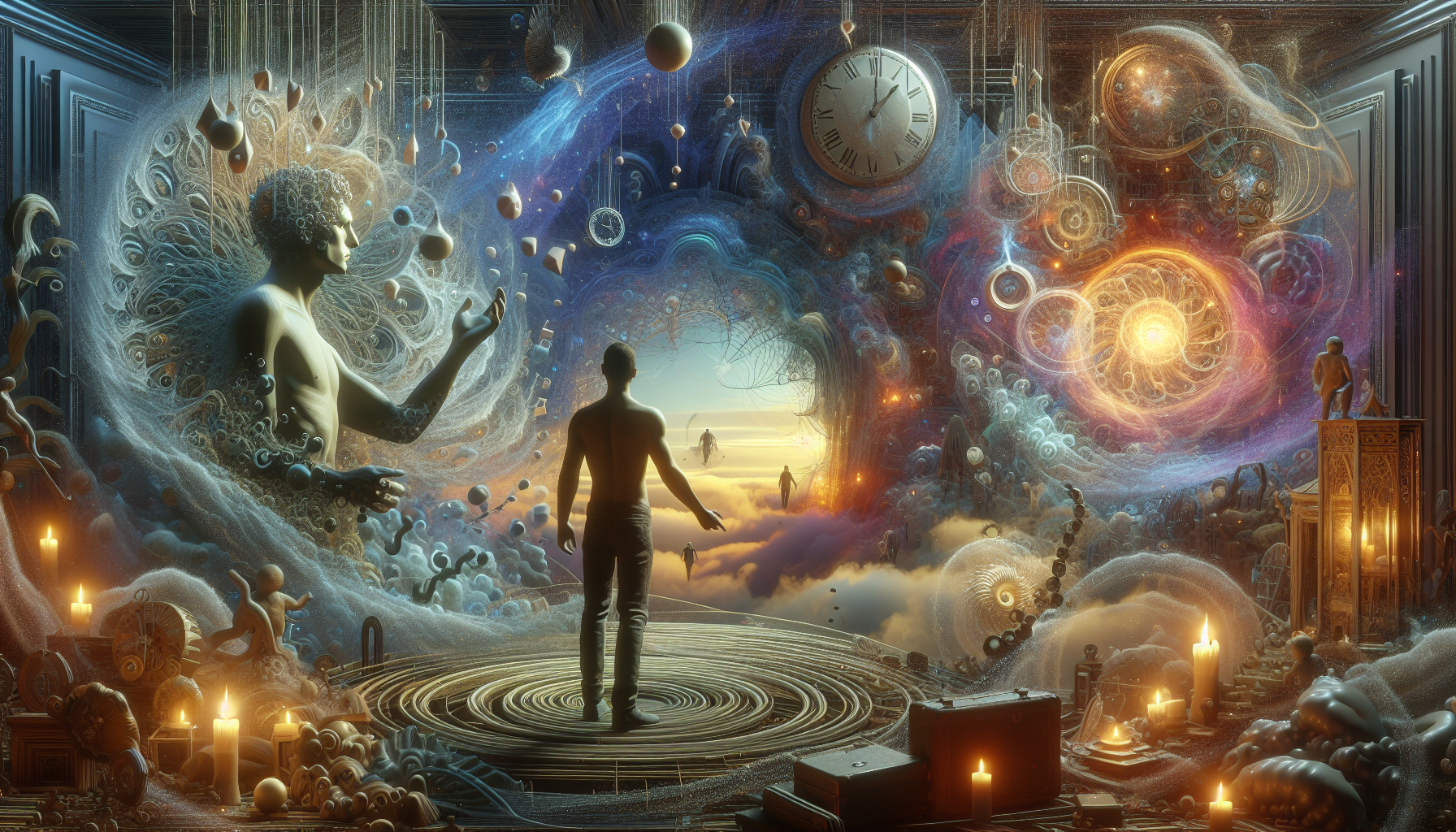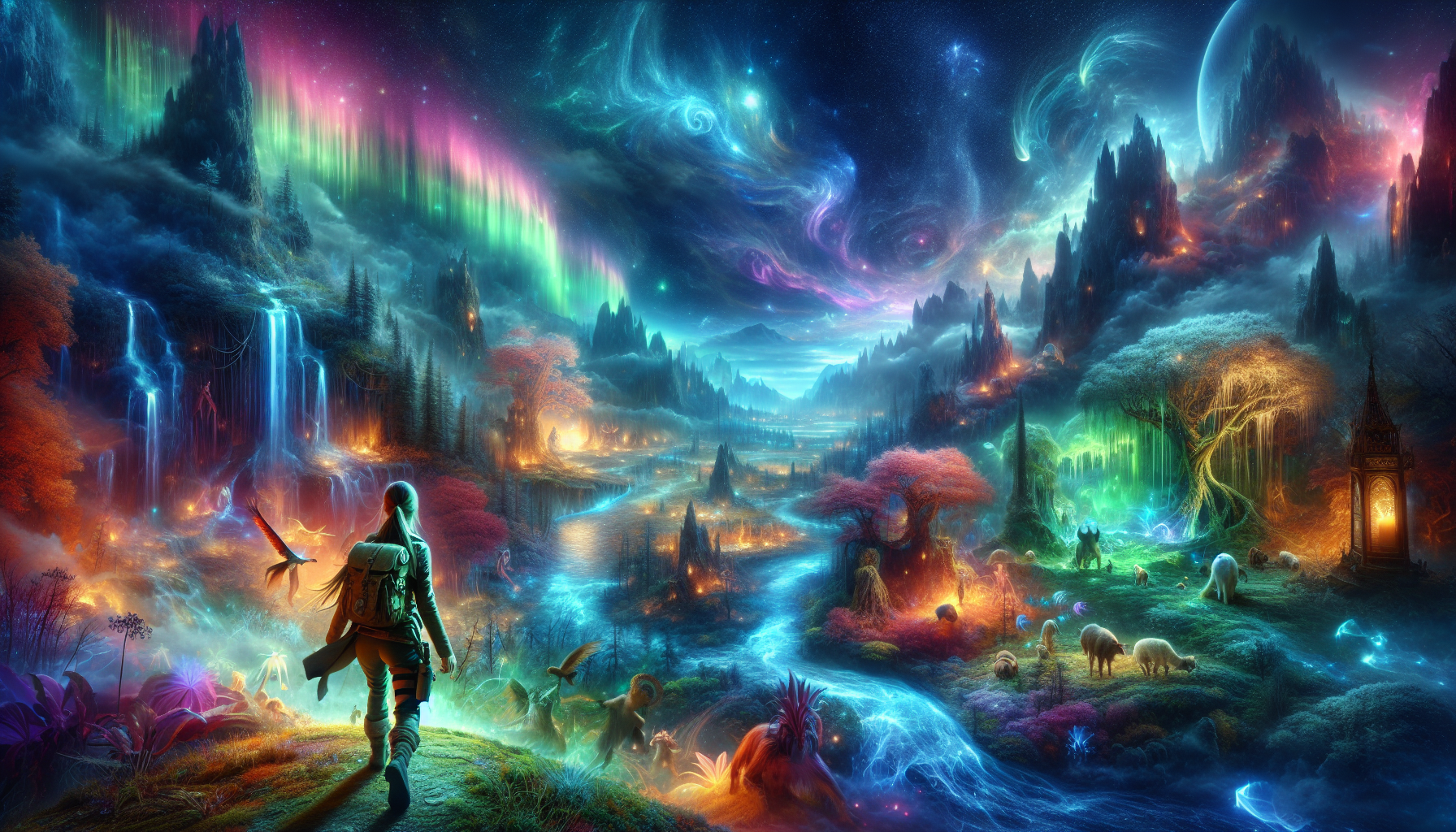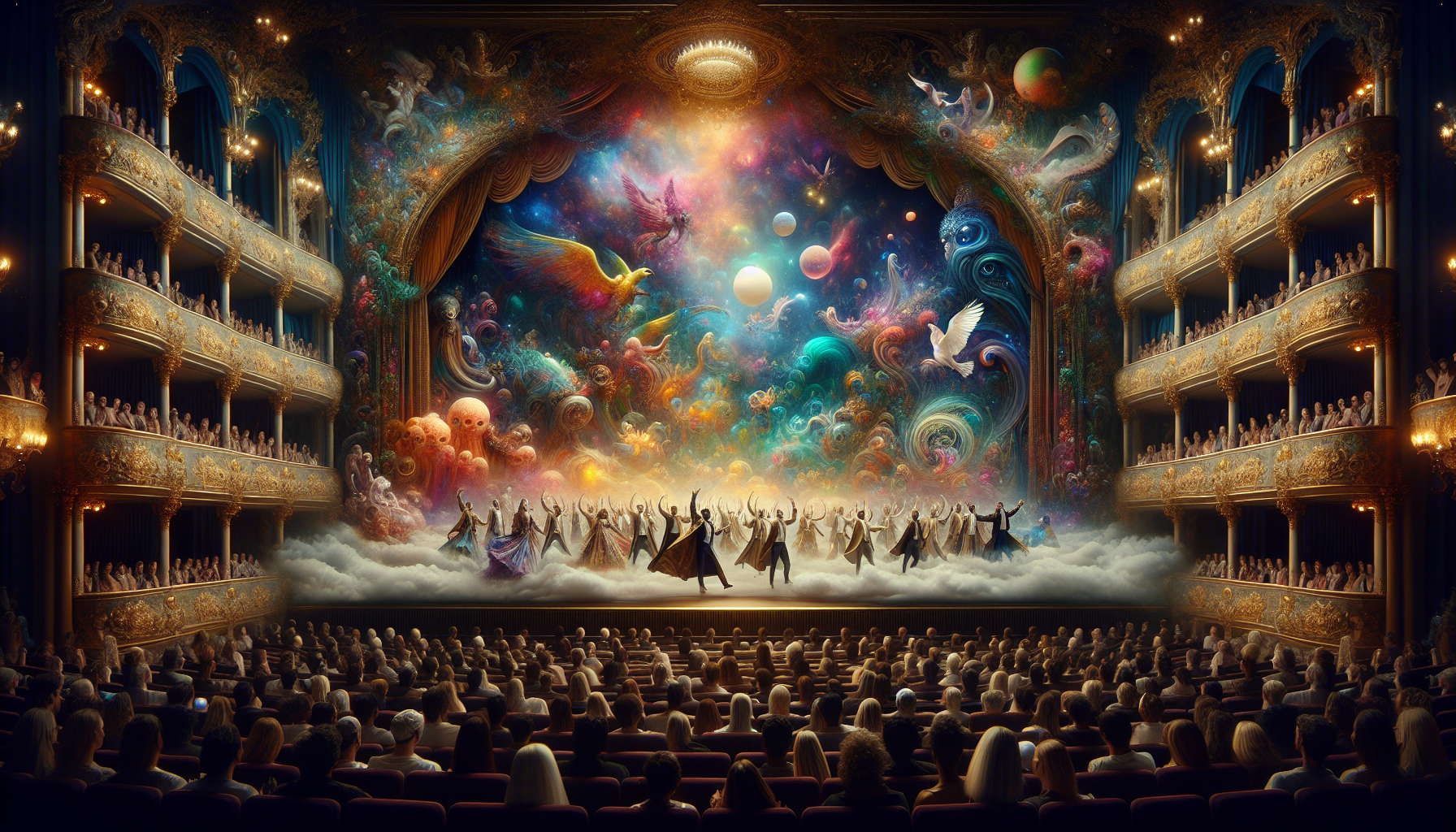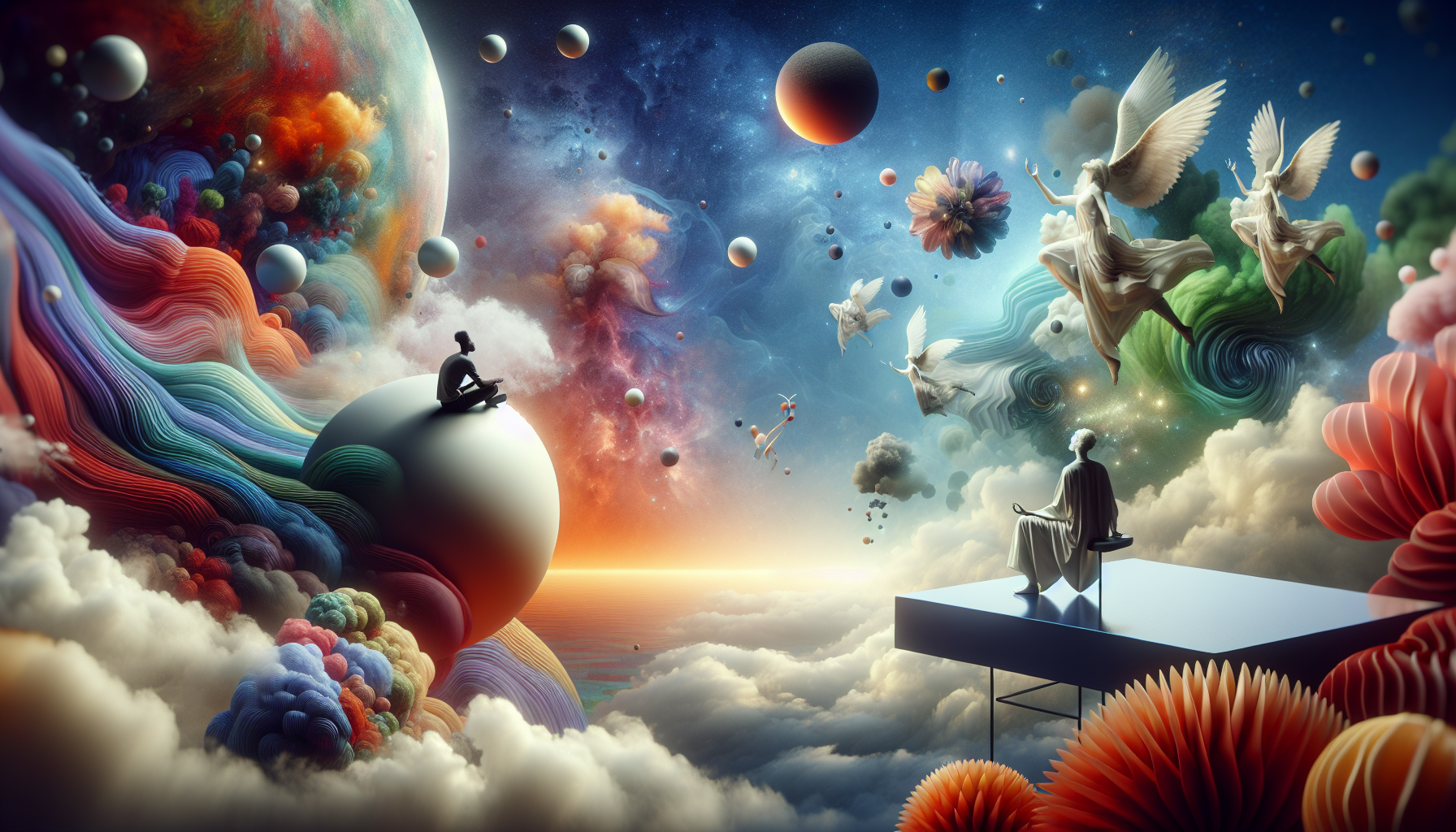In the vast and uncharted territory of the human mind, dreams hold a special place as enigmatic, mysterious, and often baffling phenomena. They are windows into our subconscious, offering glimpses of our deepest fears, desires, and thoughts. But what if we told you there’s an even deeper layer to explore? What if dreams themselves could host other dreams, creating a complex, labyrinthine reality where consciousness folds into itself? Welcome to the fascinating world of nested consciousness and dreams within dreams—a mind-bending concept that challenges our understanding of reality, perception, and the very nature of consciousness itself.
The idea of dreams within dreams isn’t just a captivating plot device in movies and literature; it’s a concept that invites us to ponder the intricate architecture of the mind. How do these multi-layered dreams work, and what do they reveal about our psychological landscape? Are they mere figments of an overactive imagination, or do they serve a deeper purpose in our cognitive and emotional processes? As we embark on this exploration, we will unravel the mysteries of nested dreams, drawing from scientific research, philosophical discourse, and cultural interpretations to piece together this mesmerizing puzzle.
Throughout this journey, we will delve into the neuroscience behind dreaming, examining how the brain constructs these vivid narratives while we sleep. We will explore the phenomenon of lucid dreaming and how it offers a unique gateway to understanding nested dreams. What happens when we become aware that we are dreaming within a dream? How does this awareness alter our perception of reality, both in the dream world and upon waking? We’ll also venture into the philosophical implications of nested dreams, questioning the nature of consciousness and reality itself. Can these layered dreams be likened to the layers of consciousness we experience in our waking lives, and what insights can they provide into the workings of the human mind?
Join us as we dive deep into the depths of nested consciousness, where dreams within dreams open up new dimensions of understanding. We’ll navigate through the corridors of the subconscious, guided by the latest scientific findings and age-old wisdom, to uncover the secrets held within these enigmatic experiences. Whether you are a dreamer, a skeptic, or simply a curious mind eager to explore the intricacies of human consciousness, this exploration promises to be as enlightening as it is mind-bending. So, get comfortable, let your imagination take flight, and prepare to journey into a realm where the boundaries of reality blur, and the mind reveals its hidden depths. 🌌
The Fascinating World of Nested Consciousness
The concept of nested consciousness, where layers of awareness intertwine within our dreams, provides a captivating lens through which to explore the complexities of the human mind. This phenomenon, often depicted in literature and film, is not only a rich source of artistic inspiration but also a profound subject of scientific inquiry. As we delve into the depths of dreams within dreams, we find ourselves questioning the nature of reality, the power of the subconscious, and the infinite possibilities of our inner worlds.
Nested consciousness challenges our understanding of linear thought processes. In this state, individuals experience multiple levels of awareness, each layer possessing its unique attributes yet interconnected with the others. The experience is akin to a set of Russian dolls, where each doll contains another, smaller one. This analogy helps us visualize the intricate layers of consciousness and the surreal experiences they encapsulate.
To better understand this phenomenon, it is essential to explore its roots in psychology and neuroscience. Researchers have long been fascinated by the brain’s capacity to create vivid dreamscapes that blur the lines between imagination and reality. Recent studies suggest that during REM (Rapid Eye Movement) sleep, the brain is highly active, and this heightened state of activity may facilitate the occurrence of nested dreams. By examining the neural mechanisms behind dreaming, we can gain insight into how and why these intricate dream layers form.
The Science of Dream Layers
In the realm of neuroscience, the study of dreams is closely linked to our understanding of consciousness itself. Dreams, particularly nested dreams, offer a unique opportunity to explore the brain’s ability to simulate experiences and construct alternative realities. One theory posits that nested dreams occur when the brain attempts to integrate new information with existing memories, creating a complex tapestry of dream layers that reflect our waking experiences.
Research has shown that the prefrontal cortex, responsible for higher-order thinking and decision-making, is less active during REM sleep. This reduced activity may allow for more fluid and creative thought processes, enabling the mind to construct elaborate dream scenarios that defy the constraints of reality. Additionally, the amygdala, which regulates emotions, remains highly active during REM sleep, suggesting that emotional processing plays a significant role in the formation of nested dreams.
To further illustrate the science behind nested consciousness, consider the following table that compares the brain activity in waking states versus during REM sleep:
| Aspect | Waking State | REM Sleep |
|---|---|---|
| Prefrontal Cortex Activity | High | Low |
| Amygdala Activity | Moderate | High |
| Creativity | Constrained | Enhanced |
| Emotional Processing | Linear | Fluid |
These findings suggest that nested dreams may serve as a mechanism for emotional regulation and creative problem-solving, allowing individuals to explore complex emotions and scenarios in a safe, simulated environment. As you ponder these possibilities, consider watching the video below, which delves deeper into the intricacies of dream states and their impact on our waking lives.
Understanding the Complexity of Dreams – [Channel Name]
Exploring Cultural Interpretations of Nested Dreams
The concept of nested consciousness is not only a subject of scientific interest but also a rich vein of cultural and artistic exploration. Throughout history, cultures around the world have interpreted dreams as messages from the divine, reflections of the subconscious, or even windows into alternate realities. These interpretations offer valuable insights into how different societies perceive the phenomenon of nested dreams.
In many indigenous cultures, dreams are regarded as sacred experiences that connect individuals with the spiritual realm. Shamans, for example, often embark on dream journeys to seek guidance, healing, and insight. These dream journeys frequently involve multiple layers of consciousness, where the dreamer navigates through various realms to communicate with spirits or ancestors. This cultural perspective highlights the spiritual significance of nested dreams and their potential to reveal hidden truths.
Similarly, in Eastern philosophies, dreams are often seen as a reflection of the mind’s inner workings. In Buddhism, for instance, the concept of “maya” or illusion is central to understanding the nature of reality. Dreams, particularly nested dreams, are perceived as manifestations of maya, illustrating the illusory nature of the material world. This philosophical framework encourages individuals to seek enlightenment by recognizing the transient nature of their perceptions and experiences.
Nested Dreams in Popular Culture
Beyond spiritual and philosophical interpretations, nested dreams have captured the imagination of artists and storytellers for centuries. From ancient myths to modern cinema, the concept of dreams within dreams serves as a powerful narrative device that challenges audiences to question the nature of reality and perception.
One notable example is the film “Inception,” directed by Christopher Nolan, which explores the idea of entering and manipulating multiple layers of dreams to influence a person’s thoughts and actions. The film’s intricate plot and stunning visuals illustrate the complexity and unpredictability of nested consciousness, leaving viewers questioning the boundaries between dreams and reality.
Other works of literature, such as Lewis Carroll’s “Alice’s Adventures in Wonderland,” also delve into the surreal nature of nested dreams. Alice’s journey through a fantastical world reflects the mind’s capacity to create alternate realities, where logic and reason are suspended, and imagination reigns supreme. These artistic interpretations not only entertain but also provoke thought and introspection about the mysteries of the subconscious.
- “Inception” (Film) – Directed by Christopher Nolan
- “Alice’s Adventures in Wonderland” (Book) – Written by Lewis Carroll
- Shamanic Dream Journeys (Cultural Practice)
As you explore these cultural interpretations, take a moment to consider how your own dreams reflect your personal experiences, beliefs, and emotions. Engaging with these stories and traditions may inspire you to delve deeper into your subconscious and uncover the layers of meaning within your dreams.
Practical Applications and Personal Exploration
While the study of nested consciousness offers profound insights into the nature of the mind, it also presents opportunities for personal growth and self-discovery. By engaging with our dreams and exploring the layers of our subconscious, we can gain valuable insights into our emotions, desires, and fears. This process of introspection and reflection can lead to greater self-awareness and emotional resilience.
One practical approach to exploring nested dreams is through the practice of lucid dreaming. Lucid dreaming occurs when individuals become aware that they are dreaming and can exert some control over their dream environment. This heightened state of awareness allows dreamers to navigate multiple layers of consciousness intentionally, offering a unique opportunity to engage with their subconscious mind.
Research suggests that lucid dreaming can be cultivated through various techniques, such as reality testing, maintaining a dream journal, and practicing mindfulness meditation. By developing the ability to lucid dream, individuals can explore the depths of their subconscious, confront fears, and even rehearse desired outcomes in a safe, simulated environment.
Benefits of Exploring Nested Dreams
Engaging with nested dreams can offer several benefits, both psychologically and emotionally. Here are some of the potential advantages of exploring this fascinating realm of consciousness:
- Emotional Processing: Dreams provide a safe space to process complex emotions and experiences, allowing individuals to gain insights and closure.
- Creative Inspiration: The fluid and unrestricted nature of dreams can inspire creativity, offering fresh perspectives and innovative ideas.
- Problem-Solving: Dreams can serve as a platform for rehearsing solutions to real-life challenges, enabling individuals to approach problems with greater clarity and confidence.
- Self-Reflection: By exploring the layers of their subconscious, individuals can gain a deeper understanding of their beliefs, values, and desires.
As you embark on your journey of self-exploration through nested dreams, remember to approach the process with curiosity and openness. By embracing the mysteries of the subconscious, you can unlock new dimensions of understanding and personal growth. 💤
For those interested in delving deeper into the practice of lucid dreaming, consider exploring the following resources:
- Lucid Dreaming: A Beginner’s Guide – [Channel Name]
- Books on Lucid Dreaming Techniques
- Workshops and Online Courses on Dream Exploration

Conclusion
In traversing the intricate landscapes of consciousness through the phenomenon of dreams within dreams, we have embarked on an exploration that challenges our conventional understanding of reality and the subconscious mind. This article has delved into various facets of nested dreams, examining their potential meanings, implications for self-awareness, and the neuroscientific perspectives that aim to decode their mysteries.
Throughout our discussion, we have revisited the fundamental concept of dreams as a gateway to the subconscious, where nested dreams act as a multi-layered experience that offers deeper introspection. This phenomenon, often portrayed in popular culture and art, invites us to question the boundaries between the conscious and unconscious mind, and how these layers of dreaming might reflect our innermost thoughts, fears, and desires. By engaging with such dream states, individuals may gain enhanced self-awareness and insights into their mental states.
Significant emphasis was placed on the scientific underpinnings of dreaming, particularly the role of the brain’s REM (Rapid Eye Movement) phase, where most vivid dreaming occurs. We explored how advancements in neuroscience are progressively unveiling the complexities of dream architecture, offering clues to understanding the occurrence of dreams within dreams. These insights have profound implications, not only for psychology and cognitive science but also for our philosophical inquiries into the nature of consciousness itself.
Moreover, the discussion highlighted cultural interpretations of nested dreams across various societies, underscoring how different cultural backgrounds can influence our perception and interpretation of these experiences. This cultural lens enriches our understanding and appreciation of the diverse ways humans interact with their dream worlds, revealing the universality and individuality of dreaming.
The exploration of nested dreams also led us to consider the potential applications of such experiences in therapeutic settings. Lucid dreaming, a state where dreamers are aware they are dreaming and can sometimes exert control over the dream narrative, was discussed as a potential tool for addressing psychological issues such as anxiety and trauma. Through guided exploration of dreams within dreams, individuals might find pathways to healing and personal growth.
In reinforcing the importance of this theme, it becomes evident that dreams within dreams offer a profound opportunity for both self-discovery and scientific inquiry. They serve as a reminder of the complexity of the human mind and the vast potential that lies within our subconscious. As we continue to investigate these inner realms, we may unlock new dimensions of understanding about ourselves and the nature of consciousness.
As we conclude this exploration, we invite you, our readers, to engage actively with the ideas presented. Reflect on your own dream experiences and consider keeping a dream journal to capture the nuances of your subconscious explorations. Share your thoughts and insights with others, fostering a community of curiosity and learning. By doing so, you contribute to a collective understanding of this fascinating aspect of human cognition.
We encourage you to share this article with others who might find the subject intriguing, sparking conversations about the mysteries of the mind and the rich tapestry of dreams. Whether through social media or personal discussions, your engagement helps expand the discourse around nested dreams and consciousness.
In this journey through the depths of nested consciousness, let us remain inspired by the boundless potential of the human mind. As we dream, let us also awaken to the endless possibilities that lie within us. 🌌💭
For further exploration of the science of dreams, consider resources such as The Sleep Foundation, and for insights into the therapeutic applications of dreaming, The Lucidity Institute offers valuable information.
Thank you for joining us on this mind-bending exploration. Keep dreaming and exploring!
Toni Santos is a visual storyteller and dream archivist whose work explores the delicate boundary between memory and imagination. Through layered visuals and symbolic design, Toni captures the fleeting essence of dreams — those strange, beautiful, and sometimes haunting fragments that drift through sleep and linger in waking thought.
His creative journey is rooted in a deep fascination with the subconscious and the imagery it conjures. From half-remembered landscapes to recurring symbols and surreal encounters, each piece Toni brings to life becomes a portal into the inner archive — where time distorts, meanings shift, and personal mythology takes form.
With a background in handcrafted artistry and visual composition, Toni merges intuition with intention. His work doesn’t just depict dreams; it preserves them, translating ephemeral moments into tangible expressions that evoke emotion, curiosity, and quiet revelation. Each visual is both a record and an invitation to explore the rich terrain of inner life.
As the guiding voice behind Vizovex, Toni offers illustrated dream journals, symbolic studies, and visual essays that help others connect with the poetic structure of their own subconscious landscapes. His art becomes a mirror — not just of what we see at night, but of what we carry deep within.
His work is a tribute to:
The fragile beauty of forgotten dreams
The language of symbols in the subconscious mind
The inner worlds we visit but rarely name
Whether you’re a lucid dreamer, a seeker of hidden meanings, or someone fascinated by the mystery of sleep-born stories, Toni welcomes you to step into a space where dreams are not lost — they are archived, one vision, one sketch, one silent narrative at a time.





